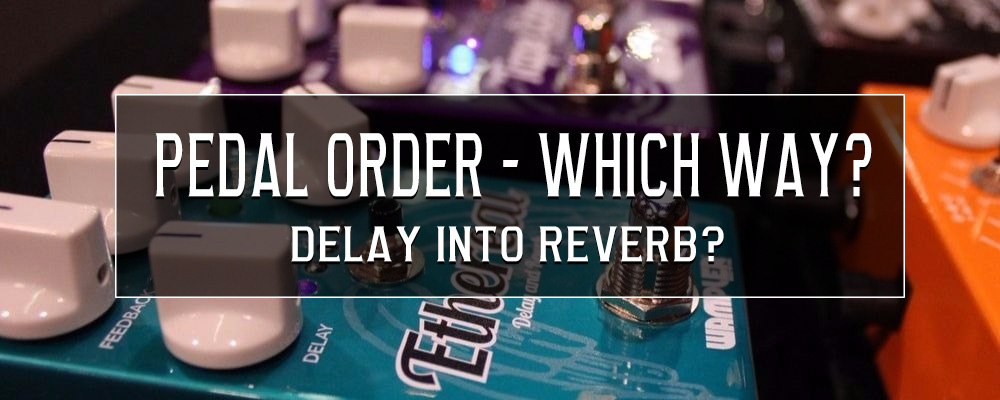

Which order do you put your delay and reverb pedals? For years and years I was a firm subscriber to the most common way of delay into reverb… once I had started to play in LogicX, you know – just messing around, I was surprised at how different, albeit quite subtly, the order of these two effects can make the final ‘product’. When I’m in full gig mode, and I’m guessing this is the same with you, it’s not really something I think about too much, but in recent times I’ve been running them parallel and really started to notice how cleaner and clearer everything is. Which is quite an achievement when you consider what a noisy bugger the drummer is.
I’m going to approach this quite scientifically, with the exact same guitar line running through the various options… the line is only 36 seconds long, it’s not a song – just some ‘stuff’ with some intentional stabby bits in so you can hear what is happening. I suspect you might get bored of the same line by the time you’ve got to the last example, but stick with it, as it’s the end one that really highlights how important this is.
First of all, here is my clean tone (is that copyright Andy Martin yet??). To make this simple for myself I used the Helix Native plug-in set on a fairly standard clean Deluxe style model running through a 2×12”. All you are hearing is my PRS Brent Mason, single coil mode, pickup position 4, straight in. There is a fraction of compression up front (and of course whatever YouTube applies at the end…), I’ve recorded it at 41k, .wav and crunched it out at 1080p in the hope that the sound is as clear as possible. I would definitely recommend listening to this under headphones or through a decent set of speakers, as your phone speakers will mush it up further.
The compression, amp, delay and reverb settings are unchanged in any of the examples – they are the same throughout.
Here is the delay line. As you can hear, it’s a modulated delay with a few repeats, nothing startling, but it’s intentionally quite overbearing.
Here is the reverb line. It’s quite a large ambient thing, definitely not something I would usually use, but I needed something large!
Here is the delay into the reverb. As you can hear, the reverb sounds bigger as it’s also reverberating the delay repeats as well, this is where things start to get kinda mushy if you really listen to it. – the reverb feels like it is starting to take over, and the end result is that the whole ambient reverb side is overpowering the main playing line.
Here is the reverb into the delay. To my ears, the delay has lost a little edge and is further back in the mix. It sounds more ambient and bigger as the reverb is also taking the delay lines and reverberating them. The modulation on the delay is falling over itself in places… it’s kinda cool, and a little trippy, but it’s even further lost in terms of the original piece of playing.
Here is final one. As you can see from the signal chain path on the video, the delay and reverb are running parallel to each other so they are not feeding into each other in any way. The feel of separation is clear and everything rings out the way it does in the separate videos. Now, this is easy on the Helix as you can drag a separate path for each, but these days there are a lot of products out there that allow you to separate them and, run in parallel, and then put them back together afterwards, for example the EHX Tri-Parallel mixer and the EQD Swiss Thing. Personally, I particularly like the WetterBox from the GigRig for this… it has the options and features to make sure your signal path is flawless.
If you would like to hear it all again, running one after the other, here is a longer video with them all back to back! I’ve put the Parallel one in the middle of this, because it I wanted you to listen again with (what I think is the) best way before it gets mushy.
Like I said, it’s subtle when using normal delay and reverb style (normal for me anyway), but I’ve tried to use delay and reverb sounds that will show the difference it would make in the real world, even if these aren’t the kind of delays and reverbs you would normally use, you can hear what a difference it makes how you stack them – remember though, there is no right or wrong way to do this – you need to try it, explore it, see what works for you and then go in that direction, it might be that you use multiples ways of doing it within your playing!



0 Comments